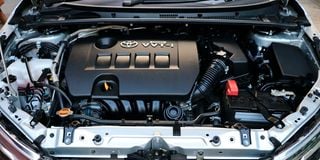
VVT-I Engine.
More and more readers are asking about the latest VVT-i engines, which have technology to improve both performance and economy. Questions range from how “real” these improvements are to “reliability” issues, whether they require higher grade oils and whether they are superior to EFi engines.
First, VVTi engines are already and also EFi engines. VVT-i (variable valve timing-intelligent) is an additional technology, not an alternative to or another version of fuel injection.
On all engines the timing of when inlet and exhaust valves open and close, how wide they open, how long they stay open, and the timing relationship between the two processes, is important to performance, economy and the content of exhaust gases. The challenge is that the optimum settings are not constant – they vary according to what the car is doing and how it is being driven.
The best valve timing and lift for high speed and high performance is different from the best timing and lift when the car is at low revs in traffic. If set for high performance, the engine would splutter and cough at low revs. If set for low speed, performance at higher revs would be significantly reduced. The fixed opening and closing degrees in engine design are therefore a compromise of what will work adequately over a full range of conditions.
Computerised engine management systems can fine-tune that to some extent by monitoring and adjusting the supply-and-demand balances of air and fuel and other settings. What VVT-i adds is an ability to change the valve timing (in accordance with computer monitoring and instructions). In layman’s terms, it reduces the amount of compromise in fixed settings by offering more settings.
VVT-i was pioneered by Toyota more than 20 years ago, but many other makes have followed that lead and there are now an increasing number of VVT-i configurations with ever-more “clever stuff”.
The theoretical benefits are not in doubt, and VVT-i delivers them by enabling the timing and degree of valve opening and closing to be varied, independently and collectively. However, this is new technology is highly complex (with components like oil-immersed solenoids) and thus more sensitive, especially to things like the level, grade and condition of the engine oil.
VVT-i is not a passing fad; it is a real design advance that is likely to get increasingly reliable and assured. But it is inherently more demanding of setting and service precision. Bear in mind that engines have at least 8 valves which open and close many thousands of times per minute. Engine oil is in the front line of that blizzard of microsecond movements, and manufacturers are likely to recommend top grade synthetic oils with lower “cold” weights (5W40 rather than 10W40) to ensure swifter delivery of lubrication on start up, for example, and perhaps more frequent oil changes to reduce the risk of clogging vital channels.
Consumers will need to be careful in judging the comparative economy and performance of EFI only versus EFI + VVTi. The figures will be there, but are unlikely to involve vehicles that are identical in every other respect. Nett differences might not be readily or entirely attributable to a single factor.
Why Kenya took long to catch up to the global motor vehicle craze initially

Army truck.
History suggests motoring in Kenya made a very slow start. Why did it take so long to become mainstream, and what were the most important factors in its later growth? Ken W.
There wasn’t a great rush to showrooms anywhere in the world when cars were first invented. Apart from there not being any showrooms, the cars themselves were awful! They were slow, smelly, bumpy, unreliable, and required extraordinary levels of maintenance to manage even that. Horses (with or without carts and carriages) and bicycles were definitely simpler, quicker, less trouble and less expensive.
Initial car purchase prices were neither modest nor exorbitant. Upper-Middle incomes might have enabled you to buy one, but you had to be wealthy to run it, because it needed a “motor house” (a shed kitted out as a mini workshop), a full-time mechanic to elaborately service it (every day, and sometimes more often), chronic repair and replacement of tyres, and frequent “engineering” of replacement parts, commonly in places like the Railway Workshops. They were also difficult to start, hair-raising to drive, and notoriously uncertain in matters like steering and stopping.
Kenya had the added handicaps of very few motorable roads; there were 22 years between the first car arriving by ship in Mombasa and the first car driving itself from there to Nairobi – a journey that took several days – as opposed to being carried inland on a train. Bear in mind that there were no petrol stations – fuel came to Kenya in debe tins, packed four to a crate, and was sold by chemist shops. The few cars were avidly followed everywhere by low-income pedestrians. But not because of any automotive passion. They wanted the tins they left behind. Distances between centres were long, through wild places, and over surfaces that were dramatically altered by rain.
So, cars were few, and elitist, and used mainly to satisfy man’s passion for sport! They were widely regarded as a hobby item for bizarre racing rather than a revolutionary and universal means of transport.
Any change that would make cars less rare and eccentric had to begin with technical development of the vehicles themselves. They got faster, a bit smoother (pneumatic tyres), more precisely controllable, more reliable, and needed less elaborate daily attention. In parallel, town streets got more motorable (although major bog-ups even in the centre of Nairobi were still commonplace).
But these evolutions still only changed the vehicle population from dozens to hundreds. Two things exploded that to several thousand: One was a World War. The other was the Model T Ford.
By the start of the Great War (in 1914) vehicles were sufficiently improved to make a mechanised cavalry viable, and even essential. This was operated by a military division known as the Carrier Corps, which in Nairobi had its main depot in a place now called (wait for it) Kariokor.
They used light trucks as troop carriers, to carry supplies to the battlefront, and as field ambulances. Some had their bodies armoured and had heavy machine guns mounted on them, and others were fitted with lipped metal wheels so they could drive down railway tracks as personnel carriers, all-weather supply lines, mobile radio relay locations etc.
All of these vehicles were operated by ordinary folk, now in uniform, as drivers, passengers, mechanics, loaders, gunners etc. All became more familiar with the idea, operation and utility of motor vehicles, and many got good at it. So, when the war ended, there was a much broader proportion of the population that knew what was what and wanted it. All that was needed to ensure a boom was a vehicle they could afford, and simultaneously Henry Ford delivered that, by combining a super-simple design using low cost materials and the nascent principles of mass production (which had been handsomely financed and developed by the US war budget). The same was to be repeated a few decades later, with development of the Jeep for World War II.
Meanwhile, the First World War and the Model T economies and production scales launched motoring into the mainstream, everywhere, and that inevitably accelerated investment and know-how in infrastructure, more technical advances; all with exponential market forces to drive the process.
Quite quickly there were tens of thousands of vehicles, and all the kit and caboodle of motor companies, workshops, spares shops, fuel stations and so on, as supply raced to match demand.
Between then and now there have been two other step changes in Kenya. One was an explosion of the human population after independence (from 8 million in 1963 to now possibly 60 million). For three decades this caused a progressive shortage of vehicles (there were about 250,000), until the advent of “liberalisation” in the 1990s had the same effect as the Model T – delivering vehicles that were more affordable to more people. Used imports. Mitumba. That has increased the vehicle population 10-fold…so far.
The roofrack dynamics to consider

What is the best way to shape and position the load on a roofrack to maximise stability and minimise wind resistance? NW
Roof loads are very variable in size and shape, and there are other considerations like weight distribution, so I doubt there is a single formula that answers your question. The basic principles are to keep the load as low as possible (spread rather than piled), and to shape it as a smooth mound to avoid large vertical surfaces at front, rear or sides.
In all directions, progressive “slopes” are more aerodynamic than “walls”. At the front, walls obstruct airflow like a dam. At the back, they create suction (drag). At the sides they act like a sail that could upset stability in a strong cross-wind.
Whatever the cause or level of wind resistance, bear in mind that it increases exponentially with speed. Cars that are likely to travel fast need to be much more careful and conservative than those that plod. You might have to compromise either your cargo or your timetable accordingly.
As stability is primarily determined by the vehicle’s centre of gravity, you need to recognise that putting 100 kilos of additional weight well above the roof will have a far greater effect on cornering stability (several times larger) than putting the same load in the boot.
There is no one-size-fits-all for roof load weights; it depends on the weight and shape of the vehicle, and the strength of the rack and its mountings. Generally, loads of up to 100 kilos are viable for most cars; preferably less for small vehicles and a bit more for big and heavy 4WDs.
Security of a roof load is also imperative. It should be tied down tightly and comprehensively enough, using restraints that are strong enough, that it will not move forwards or backwards or sideways or upwards; even if the vehicle is launched into mid-air by a speed bump, or is involved in a severe collision at front or rear or side, or if it rolls over completely.
“Modern roof luggage boxes or pods are all designed to a teardrop principle which offers the most aerodynamic shape – less wind resistance and less noise”.







